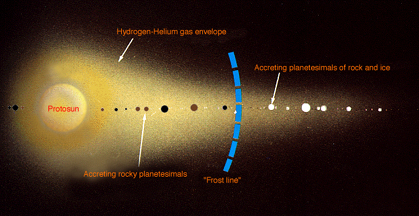This drawing depicts a position where the formation of ice became important.
Click on image for full size
Windows Original
The position of Neptune when gas changed to ice
The position of the planets in the solar nebula affected how big they became and what they were made of. The blue line in the picture shows where it became so cold that ice began to form.
Planets that formed beyond the blue line drew ice to them, plus molecules of rocks and gas. Keeping ice resulted in these forming planets becoming big and full of gas. The planets that formed close to the sun became small and full of rock.
But, as far away as Neptune was in the nebula, the cloud was thin and there wasn't as much gas, so proto-Neptune was not able to sweep up as much gas as the proto-Jupiter. Thus Neptune is much smaller than Jupiter.
You might also be interested in:
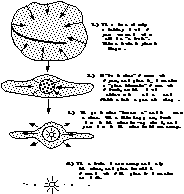
Scientists think that the solar system formed out of a spinning cloud of hydrogen and helium molecules. Because the cloud was spinning, it flattened into a frisbee shape, just like a ball of pizza dough
...more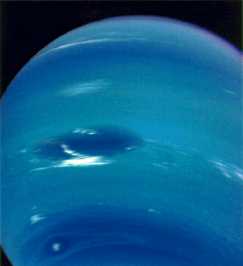
The giant planets have definitely changed since their formation. But how much remains to be seen. Most of the original air of the giant planets remains in place. (The earth-like planets lost most of their
...more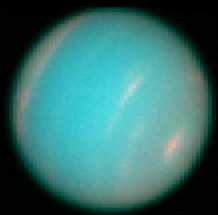
This image shows the new Great Dark Spot of Neptune, which was discovered using the Hubble Space Telescope. The image shown here, shows a large "hole" in the clouds of Neptune in pink, in the northern
...more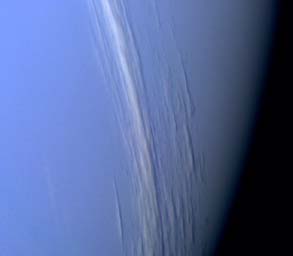
This image shows some clouds known as "cirrus" clouds, extending for many kilometers across the face of Neptune. These clouds are very high up, for they can be seen to cast shadows on the lower clouds,
...more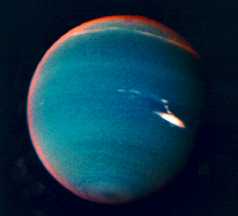
This image of Neptune uses false colors to show where the smog is. The smog of Neptune can be seen in red along the edge of the image. This smog haze is found very high up in the atmosphere, over the clouds
...more
Like Jupiter and all the giant planets, Neptune's appearance shows a striped pattern of clouds. Other cloud shapes seen over time include a small dark spot, the "scooter" and the Great Dark Spot. The Great
...more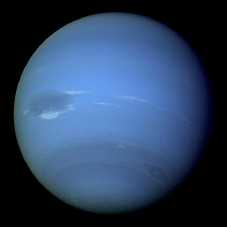
Neptune was discovered in 1846. But it wasn't discovered using a telescope. Scientists used math instead! They watched Uranus and saw that its orbit was doing weird things. They knew another planet had
...more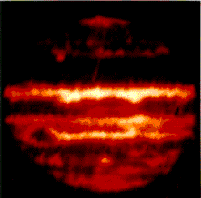
The picture shows places on Jupiter which are hot. Jupiter is a very warm place, as shown in the picture, sort of like a warm log in the fireplace which gives off heat. Like Jupiter, Neptune also gives
...more


